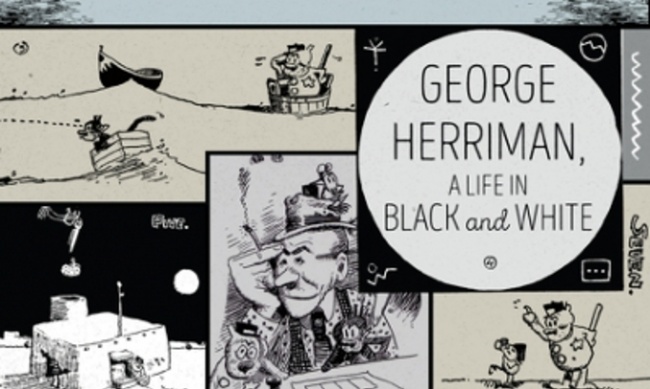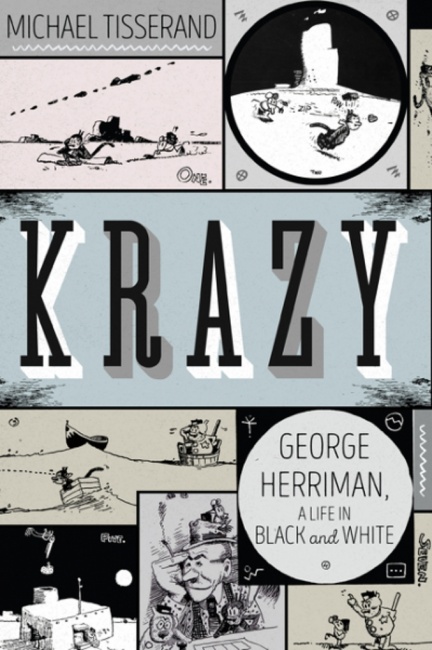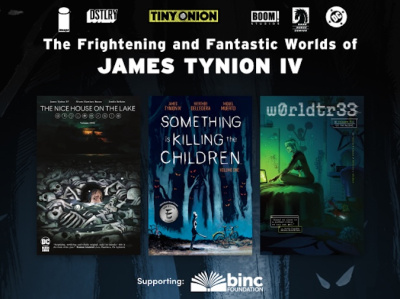Black and White and Read All Over. The fact that Herriman was of mixed race, while unknown during his lifetime, was discovered in 1971 and is today fairly common knowledge among comics scholars. Tisserand puts this issue front and center in his book, providing ample historical context for what Herriman’s racial identity, and his efforts to conceal it, meant in terms of both the practicalities of his career and the shades of meaning it brought to his art.
Herriman was born in New Orleans in 1880 and grew up in the post-Reconstruction era when the avenues of opportunity for black Americans that opened following the Civil War were being systematically and brutally closed by revanchist white politicians, angry mobs and the domestic terrorist group Ku Klux Klan. Of light complexion and hailing from a well-heeled Creole family of "free Negroes," George was able to pass for white and gain access to educational and professional opportunities that would have been denied to him on the basis of his heritage. Then, as now, that was a move fraught with guilt and complexity.
In 1890, his family moved to Los Angeles, enabling young George to make a clean break from his past. By the age of 15, he had fully assumed a white identity. He began his career as a newspaper cartoonist around the turn of the century, when newspapers were serious business. The competing media empires of Joseph Pulitzer and William Randolph Hearst sought every advantage to increase distribution, and illustrations and cartoons were the most potent weapons in their arsenal.
Tisserand spends nearly half of the book’s 450 text pages (notes and index account for another 100 pages) on Herriman’s career before the debut of Krazy Kat in 1910 and its surge in popularity during the teens. Of special interest is Herriman’s apprenticeship as a sports cartoonist for the various Hearst papers in an era where the main sports were baseball, horse racing, and above all, boxing.
The Great White Nope. The heavyweight title bout between the African-American champion James P. Johnson and "Great White Hope" Jim Jeffries was the most celebrated sporting event in US history to that date, and served as a proxy for the racial conflicts that bubbled under the surface as segregation was closing its grip on American society. Johnson’s victory stunned white America, moreso because of Johnson’s calm intelligence, confidence, wealth, and open relationships with white women. The newspapers that had hyped the fight to boost readership suddenly had to explain away the failure of white supremacy in such a public way.
Herriman, like the other staff cartoonists, was recruited into this project, and found a way to subvert it without blowing his cover. Tisserand convincingly argues that navigating these kinds of situations, which must have stirred a strong brew of emotions beneath Herriman’s placid demeanor, allowed him to perfect the ambiguity he brought to Krazy Kat which elevated the strip far above most of its peers.
Still Krazy After All These Years. Krazy was released in December, 2016 into a very different America from the one in which Tisserand did his research and writing. The sophisticated discourse around racial identity that took place in the final years of the Obama era degenerated overnight to a much more primal level. This has made a lot of the self-consciously inclusive pop culture entertainment produced on the cusp, like Marvel’s Luke Cage series on Netflix, almost painful to watch, given what the election revealed about the state of mind of a lot of white America.
But this shift in mindset has actually made Tisserand’s work even more relevant. The overt post-Reconstruction racial attitudes and anxieties, which just a few months ago seemed to be part of Krazy’s historical backdrop, have erupted into the present. The idea that the racial identity so central to white America’s self-conception could be overcome by a passing complexion and an act of will, which was radical when Herriman undertook it a century ago, then seemed almost commonplace as we elected a mixed-race President in 2008, suddenly seems radical again.
That’s not all that seems newly relevant. Part of Krazy Kat’s genius lay in how it jumbled together not just racial ambiguities, but ones of gender, class and nationality in its collision of high- and lowbrow allusions, ethnic argot, and polyamorous, cross-species romantic entanglements. Herriman celebrated this confusion as America started to come to terms with its multicultural soul in the 20s, 30s and 40s, when cosmopolitan cities and popular culture produced by immigrants, Jews and African-Americans overwhelmed and overawed the native white heartland. At the time, this all seemed like inevitable and irreversible progress toward a world where all socially-imposed identities would be seen as arbitrary, and the only hard part would be sorting through the myriad possibilities.
A Brick to the Head. Herriman, born into an America where doors were closing for people of his background, delighted in kicking them open with his imagination, but chose to do so behind a mask because of the limitations that would have been placed on his genius if he had embraced his racial heritage. As those doors threaten to start closing again, Tisserand’s splendid and timely biography reminds us that even hard-won triumphs are only provisional, and that masks can be laid aside but never discarded permanently.
The opinions expressed in this column are solely those of the writer, and do not necessarily reflect the views of the editorial staff of ICv2.com.
Rob Salkowitz (@robsalk) is the author of Comic-Con and the Business of Pop Culture.










